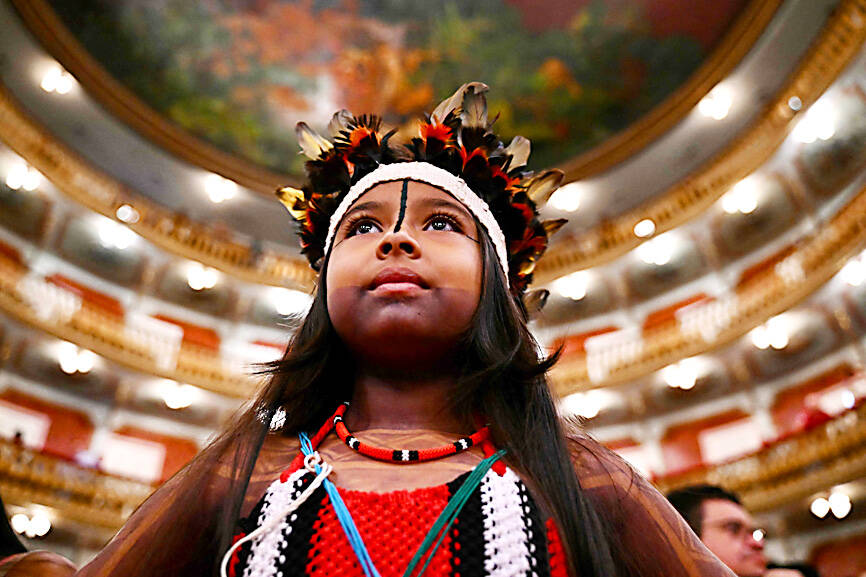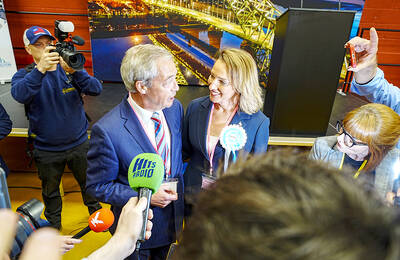The diminutive woman with a white feather headdress stood on the stage of the majestic colonial theater in Brazil’s Amazon on Monday and addressed the crowd.
The woman, Minister of Indigenous People Sonia Guajajara, declared the day “the milestone of indigenous participation,” then cited the national statistics institute’s freshly released census data that revealed the full scope of the nation’s indigenous population: 1,693,535 people.
While just 0.8 percent of Brazil’s population, the figure marks an 89 percent jump from the nation’s prior census, in 2010, due to greater willingness of people to recognize their roots and better survey methods, including access to previously unreachable villages, she said.

Photo: AFP
The latter largely explains why their numbers within indigenous territories grew 20 percent, to 622,066.
“This a historic moment with that picture that the statistics agency has made,” she said on the eve of the two-day Amazon Summit in Belem. “It’s a historic moment of the restart of social, popular participation, and of the dialogue of our civil society with government.”
The setting seemed symbolic: a theater displaying European decor — French chandeliers, Italian marble busts and a massive painting across the ceiling depicting Greek deities. It was built during the rubber boom, with fortunes amassed with raw material from deep in the Amazon, and little care for what its extraction implied for local communities. There is no trace of them in the so-called Theater of Peace — except on Monday when many of their descendants could be found from the floor seats up to the balcony boxes, wearing tribal vestments.
The gathering formed part of the events leading up to the Amazon Summit, during which presidents and representatives from the eight countries home to the world’s largest tropical rainforests converge in this city to discuss how best to face up to its myriad challenges.
In the so-called Amazon Dialogues during the days before the summit, there was surprisingly diverse participation of delegations from regions of the Amazon. Some boat trips to reach Belem took as long as five days.
In about 400 events, representatives of indigenous groups, riverine communities, fishermen and Afro-descendants discussed topics such as harassment from carbon credit companies, ending deforestation and illegal mining. One of their main demands was to cancel new oil projects in the region.
Though the large majority came from Brazil, which holds two-thirds of the Amazon, there were also representatives from all eight countries. Most events took place in the same convention center where the presidents were to start meeting yesterday.
There, indigenous Warao people from Venezuela sold crafts made of straw next to Kayapo indigenous people painting their bodies with traditional designs. Riverine community stalls sold native honey, Brazil nuts and cassava flour. There were also protests against oil exploration near the mouth of the Amazon River.
“You can clearly see that Brazil has a significant social problem to solve, a social problem left by the previous government,” Colombian indigenous leader Anitalia Pijachi Kuyuedo said, referring to the administration of far-right former Brazilian president Jair Bolsonaro. “There are many grievances, much pain, much anger, and you can feel the emotions in the words of those you speak with.”
In an interview with The Associated Press on Monday, Guajajara agreed that their anxiety has been palpable, but finally they have a forum.
“There were six years of the complete silencing of civil society, and spaces for social participation were extinguished. People became very afraid to express themselves,” Guajajara said. “This is the first moment when society is once again engaging in dialogue with the federal government.”
Brazil’s government had expected 10,000 attendees, but instead, 24,000 had arrived, Guajajara said.

Kehinde Sanni spends his days smoothing out dents and repainting scratched bumpers in a modest autobody shop in Lagos. He has never left Nigeria, yet he speaks glowingly of Burkina Faso military leader Ibrahim Traore. “Nigeria needs someone like Ibrahim Traore of Burkina Faso. He is doing well for his country,” Sanni said. His admiration is shaped by a steady stream of viral videos, memes and social media posts — many misleading or outright false — portraying Traore as a fearless reformer who defied Western powers and reclaimed his country’s dignity. The Burkinabe strongman swept into power following a coup in September 2022

‘FRAGMENTING’: British politics have for a long time been dominated by the Labor Party and the Tories, but polls suggest that Reform now poses a significant challenge Hard-right upstarts Reform UK snatched a parliamentary seat from British Prime Minister Keir Starmer’s Labor Party yesterday in local elections that dealt a blow to the UK’s two establishment parties. Reform, led by anti-immigrant firebrand Nigel Farage, won the by-election in Runcorn and Helsby in northwest England by just six votes, as it picked up gains in other localities, including one mayoralty. The group’s strong showing continues momentum it built up at last year’s general election and appears to confirm a trend that the UK is entering an era of multi-party politics. “For the movement, for the party it’s a very, very big

ENTERTAINMENT: Rio officials have a history of organizing massive concerts on Copacabana Beach, with Madonna’s show drawing about 1.6 million fans last year Lady Gaga on Saturday night gave a free concert in front of 2 million fans who poured onto Copacabana Beach in Rio de Janeiro for the biggest show of her career. “Tonight, we’re making history... Thank you for making history with me,” Lady Gaga told a screaming crowd. The Mother Monster, as she is known, started the show at about 10:10pm local time with her 2011 song Bloody Mary. Cries of joy rose from the tightly packed fans who sang and danced shoulder-to-shoulder on the vast stretch of sand. Concert organizers said 2.1 million people attended the show. Lady Gaga

SUPPORT: The Australian prime minister promised to back Kyiv against Russia’s invasion, saying: ‘That’s my government’s position. It was yesterday. It still is’ Left-leaning Australian Prime Minister Anthony Albanese yesterday basked in his landslide election win, promising a “disciplined, orderly” government to confront cost-of-living pain and tariff turmoil. People clapped as the 62-year-old and his fiancee, Jodie Haydon, who visited his old inner Sydney haunt, Cafe Italia, surrounded by a crowd of jostling photographers and journalists. Albanese’s Labor Party is on course to win at least 83 seats in the 150-member parliament, partial results showed. Opposition leader Peter Dutton’s conservative Liberal-National coalition had just 38 seats, and other parties 12. Another 17 seats were still in doubt. “We will be a disciplined, orderly